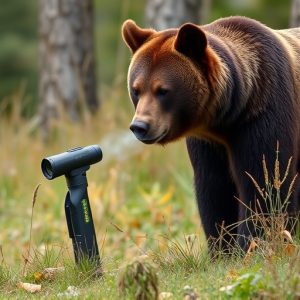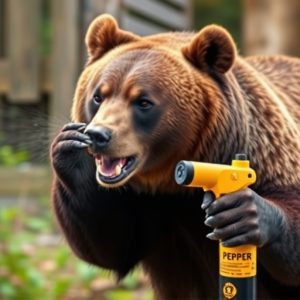Optimizing Quick Draw Access: Mastering Bear Spray Holster Design for Optimal Cloud Dispersal Range
Understanding the vital Bear Spray Cloud Dispersal Range (20-30 feet) is key to effective self-defen…….
Understanding the vital Bear Spray Cloud Dispersal Range (20-30 feet) is key to effective self-defense against bears. To maximize protection, users should position themselves strategically within this range while practicing quick draw techniques and aiming for a cone-shaped dispersion pattern. An ideal bear spray holster combines an ergonomic design with reliable attachment methods, accommodating various can sizes and optimizing the dispersal range. Regular training, including grip techniques and swift drawing, ensures instinctive reaction during encounters, adhering to local regulations for preparedness.
“Maximize your safety in bear country with an optimal bear spray holster design, ensuring quick draw access. This comprehensive guide explores the key factors influencing bear spray cloud dispersal range and how it impacts your defense strategy. From understanding the reach of bear spray to mastering training techniques, we delve into best practices for holster design. Learn how environmental conditions, your stance, and weapon placement can affect quick draw efficiency, enabling you to make split-second decisions during encounters.”
- Understanding Bear Spray Cloud Dispersal Range
- Factors Affecting Quick Draw Access
- Best Practices for Bear Spray Holster Design
- Training and Preparedness for Efficient Use
Understanding Bear Spray Cloud Dispersal Range
When considering bear spray holster quick draw access, understanding the Bear Spray Cloud Dispersal Range is paramount for effective self-defense. The range varies depending on several factors such as wind speed and direction, terrain, and the specific type of spray. Typically, bear spray can reach a maximum effective range of around 30 feet (9 meters), but the optimal range for a successful discharge and cloud formation is often closer to 20 feet (6 meters).
Knowing this range allows users to position themselves strategically within their environment. It’s crucial to practice drawing and deploying the bear spray within this range to ensure its effectiveness during an encounter. Moreover, understanding the dispersion pattern of the spray—which forms a cone-shaped cloud—helps individuals aim accurately, maximizing the area covered by the protective spray barrier.
Factors Affecting Quick Draw Access
Several factors influence the ease and speed with which a bear spray holster allows for quick draw access, ultimately determining its effectiveness in real-world scenarios. One key aspect is the bear spray cloud dispersal range. The further away the threat, the more time users have to prepare and deploy the spray accurately. However, if the bear is too close, the quick-draw design becomes critical, ensuring users can administer the spray swiftly and effectively within the limited space between them and the attacking animal.
Another factor is the holster’s ergonomic design and attachment method. A well-designed holster should securely hold the spray bottle, allowing for a smooth, uninterrupted draw while also providing comfort and ease of use during high-stress situations. The position and accessibility of the release mechanism play a significant role in how quickly the spray can be deployed. Additionally, weather conditions, such as temperature and wind, might indirectly impact quick draw access; cold temperatures can affect hand dexterity, while wind can disrupt the bear spray cloud’s dispersion, requiring adjustments to deployment technique.
Best Practices for Bear Spray Holster Design
When designing a bear spray holster for quick draw access, prioritizing ease of use and effectiveness during emergencies is paramount. The optimal design should allow for a smooth, swift withdrawal of the spray can while ensuring stability and control to prevent accidental discharge. A key consideration is the holster’s ability to maintain balance and orientation on the user’s body, even under intense movement or stress. This involves strategically placed fasteners, grip materials that prevent slippage, and designs that align with the natural movements of the arm for a seamless draw.
Additionally, the holster should be crafted to accommodate different sizes and styles of bear spray cans while ensuring consistent and reliable operation. The bear spray cloud dispersal range is an important factor, dictating the holster’s capacity to hold and deploy the canister effectively. A well-designed holster will maximize this range by positioning the spray can close to the user’s hand for immediate access, thereby improving safety during encounters with bears.
Training and Preparedness for Efficient Use
Proper training is essential for ensuring efficient use of a bear spray holster and quick draw access during an encounter with bears. It’s crucial to understand the bear spray cloud dispersal range, which typically ranges from 20-30 feet (6-9 meters), allowing you to maintain distance while applying the spray effectively. Training should cover proper grip, aiming techniques, and the sequence of actions required to deploy the spray swiftly but accurately.
Rehearsing these skills in simulated scenarios can help build muscle memory, enabling you to react instinctively when facing an actual bear. Additionally, understanding local regulations and recommendations for bear spray use is vital, as different areas may have specific guidelines on storage, disposal, and usage. Preparedness includes regularly practicing drawing and deploying the spray from your holster, ensuring it’s always within easy reach for quick access during a potential encounter.
When it comes to bear spray holster design, understanding the bear spray cloud dispersal range is paramount. Factors such as holster placement, draw speed, and ease of access play a crucial role in ensuring efficient use during encounters. By adhering to best practices and proper training, individuals can maximize their preparedness when facing potential bear threats. Remember, knowledge and quick response are key to navigating these wild encounters safely.


